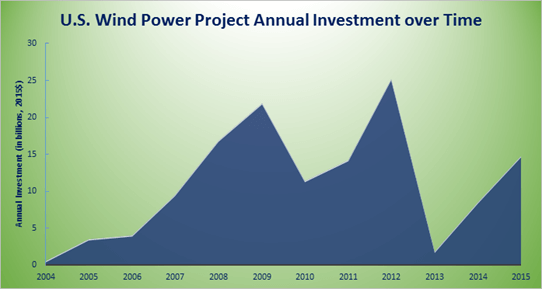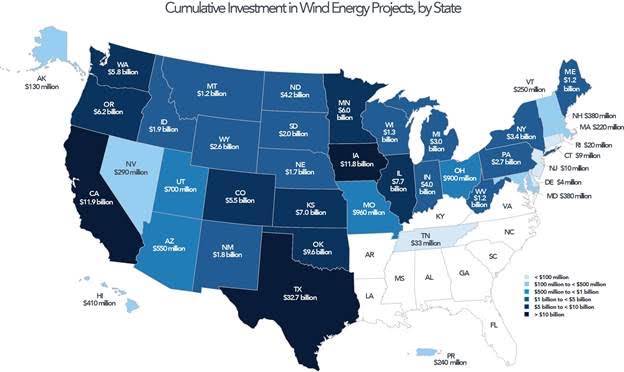Building new wind farms in the U.S has added $13 billion a year on average to the American economy over the past five years. According to information released today by the American Wind Energy Association (AWEA), that’s more money each year than the annual revenue generated by Major League Baseball.
“By building new wind farms across the country over the past decade, wind companies have invested $128 billion into the U.S. economy,” said Tom Kiernan CEO of AWEA. “Over this time, wind has rapidly scaled-up. There’s now enough wind power installed to reliably produce electricity for over 19 million American homes. Continuing to invest in world-class wind resources here at home will help keep our lights on, grow state economies, and keep more money in the pockets of homeowners and businesses.”

The recent boom-bust cycle of investment, caused by repeated expirations of the Production Tax Credit and alternative Investment Tax Credit, will now be smoothed out by the tax credits’ long-term extension through the end of the decade, as Congress approved in the budget package last December.
Wind energy was the number one source for new electric capacity additions in 2015, with 8,598 MW installed. That number translates to $14.7 billion dollars in wind project investment in one year, a 73% increase over the $8.5 billion invested in new projects in 2014 – and a more than seven-fold increase over investments by wind in 2013.
“The rapid rise of wind energy in the U.S. is clearly benefiting state economies. This American success story will continue in 2016 and beyond as there’s an additional 9.4 GW of wind under construction now, on top of 4.9 GW in advanced stages of development,” said John Hensley, Manager of Industry Data & Analysis for AWEA.
The $14.7 billion dollars in project investment last year is nearly the same amount as the total 2015 Gross Domestic Product (GDP) of Iceland, according to the World Bank. And beyond Major League Baseball, wind’s average annual project investment in the U.S. over the last five years is also the same as the annual revenue generated by the National Football League.
New analysis on wind-project investment will be featured in AWEA’s 2015 U.S. Wind Industry Annual Market Report, set for release on April 12. The upcoming annual report will provide a comprehensive update on the state of the U.S. wind market, including the latest wind industry job numbers, investment figures, state-by-state comparisons, market rankings, and more.
Across the country, wind power’s rapid growth continues to attract new investment into state economies. Texas currently leads all states in terms of cumulative project investment, with over $32 billion injected into the Lone Star State’s economy alone. Rounding out the top five states are California at $11.9 billion, Iowa at $11.8 billion, Oklahoma at $9.6 billion, and Illinois at $7.7 billion.

The new investment figures made by wind come shortly after a new accord, announced by a bipartisan group of 17 governors, made the pledge to accelerate clean energy growth, including wind power, as a way to build “a new energy future.” The accord says creating this new energy path will result in “more durable and resilient infrastructure, and enable economic growth, while protecting the health of our communities and natural resources.”
Wind power costs two-thirds less than it did six years ago thanks to American innovation and improved domestic manufacturing, with over 500 factories across 43 states building wind turbine parts and materials. Those savings are being passed on to U.S. consumers. Wind power saved consumers $1 billion over just two days across the Great Lakes and Mid-Atlantic states during the 2014 “Polar Vortex” event.
Wind energy in the U.S. produces enough electricity for more than 19 million American homes and American wind power supports 73,000 well-paying jobs across every state, including nearly 20,000 manufacturing jobs.
By staying on track to supply 20% of U.S. electricity by 2030, wind energy could support 380,000 well-paying jobs, according to the U.S. Department of Energy. That number could grow to 600,000 by supplying 35% by 2050.
AWEA
www.awea.org
Filed Under: News, Policy




